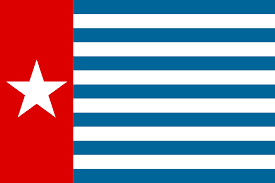What's up with OPM/Free Papua Movement?
If you are a person who loves to read about things like OPM/FPM nor TPNPB you might have heard them from a lot of shooting that's conducted in the far east part of Indonesia (West Papua and Papua), here's a blog about one of the prominent rebellion groups in Indonesia. I present to you the Free Papua Movement Aka OPM/FPM.
What's OPM/FPM?
The Free Papua Movement (FPM/OPM) is a prominent aegis label for the independence movement established throughout 1965 within the West Papua territory that is presently being administrated by Indonesia as the provinces of Papua and West Papua, conjointly once called Papua, Irian Jaya and West Irian.
In it's development, a report from IPAC (Institute for Policy Analysis of Conflict) entitled "The Current Status of The Papuan Pro-Independence Movement" says that the organisation it self is reside 3 core elements consist of a disparate group of armed units with territories such as Timika with it's lowlands and plateau though with no single commander ; several groups in the territory that conduct demonstrations and protests; and a small group of leaders based abroad that raise awareness of issues in the territory whilst striving for international support in order to reach the independence that they've wanted since 1965.
It is also mentioned inside the IPAC report of how the majority of OPM/FPM is centralized in Papua, but several of them are found in the border of Papua New Guinea. The armed units are split into three commando military wing (per 2018), each group with it's leader such as Goliath Tabuni who's the leader of the group that's based in Puncak Jaya Regency held territories such as Puncak, Mimika, and Paniai. Puron Wenda that's based in Lanny Jaya and also Richard Hans Yoweni that's based in Papua New Guinea.
The internal organisation of OPM is tough to determine. In 1996 OPM' 'Supreme Commander' was Mathias Wenda, an OPM advocate in Sydney, John Otto Ondawame, says it's 9 more or less independent commands. Australian freelance journalist, ben Bohane, says it has seven independent commands. Tentara Nasional Indonesia (TNI), Indonesia' army, says the OPM has 2 main wings, the 'Victoria Headquarters' and 'Defenders of Truth'. the former is small, and was led by M. L. Prawar till he was shot dead in 1991. The latter is way larger and operates everywhere West Papua. The larger organisation, or 'Defender of the Truth' or Pembela Kebenaran (henceforth PEMKA), was chaired by Jacob Prai, and Seth Roemkorem was the leader of Victoria Faction. throughout the killing of Prawar, Roemkorem was his commander. Prior this separation, TPN/OPM was one, underneath the leadership of Seth Roemkorem because the Commander of OPM, then the President of West New Guinea provisionary Government, whereas Jacob Prai as the Head of Senate. OPM reached its peak in organisation and management because it was structurally well organised. throughout this time, the Senegal Government recognised the presence of OPM and allowed OPM to open its embassy in Dakar, with Tanggahma because the ambassador. Thanks to the rivalry, Roemkorem left his base and visited the Netherlands. throughout this time, Prai took over the leadership. John Otto Ondawame, who had left his school of law in Jayapura due to being followed and threatened with death by the Indonesian ABRI day and night, became the assistant of Jacob Prai. it had been Prai's initiative to ascertain OPM Regional Commanders. He appointed 9 of them, most of whom were members of his own troops at the PEMKA headquarter, Skotiau, Vanimo-West New Guinea border. Of those regional commanders, Mathias Wenda was the commander for region II (Jayapura – Wamena), Kelly Kwalik for Nemangkawi (Fakfak regency), Tadeus Yogi (Paniai Regency), and Bernardus Mawen for Maroke region. These commanders are active ever since, with the exception of Kelly Kwalik who was shot and killed on 16 Dec 2009.
Why are They Formed in The First Place?
Researcher of Papua studies at the Indonesian Institute of Sciences (LIPI), Adriana Elizabeth, the Papuan pro-independence movement is the result of the unfair treatment received by the Papuan people from the Indonesian government which is considered repressive. "The violence that occurs is definitely excess, but the target is the Indonesian Army. What they imagine so far is that the presence of the state in the Indonesian Army is full of repressiveness. It is an accumulation of memories, experiences. The root of the problem is there," he said.
In the Papua Road Map book published by the Indonesian Institute of Sciences in 2009, the root causes of Papua's conflict include: discrimination, marginalization, including the lack of recognition of Papua's contribution and services to Indonesia, not optimal development of social infrastructure in Papua, particularly education, health, and people's economic empowerment, and the low involvement of indigenous Papuan economic actors, the incomplete process of political, economic, and socio-cultural integration.
In addition, the cycle of political violence has not been resolved, it is even widespread and human rights violations have not been resolved until now, particularly in the cases of Wamena, Paniai, and Wasior. "The development of infrastructure connectivity is an entry point for solving social problems needed by the Papuan people. I understand it as the fulfillment of human rights for social, cultural, and economic aspects," said Adriana Elizabeth.
That's all that i have to say on this certain topic, i hope that it can enlighten you in the matter of this rebellion group. See you next time in another blog!
SOURCES
https://www.bbc.com/indonesia/indonesia-46539502
https://en.wikipedia.org/wiki/Free_Papua_Movement


Comments
Post a Comment